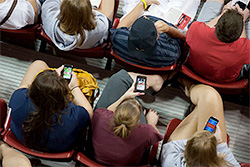Digital Distractions: Are They Harmful?
You watch, mystified, as your son or daughter juggles television, texting, and Twitter at the same time. You may own a smartphone, but can you wield it with such finesse? And if your student seems distracted under your watch, what happens in a college setting?

If you grew up studying quietly at a desk, or focusing intently on a single television show, trying to understand your student’s technology usage can be mindboggling. Without context, successfully managing multiple sources of information at the same time may seem impossible.
Can your student truly concentrate with so much going on? The short answer is yes.
First, be careful not to judge your son or daughter by your own standards.
“Everyone has a right to their own distractions,” says David Williamson Shaffer, a professor of educational psychology and a game scientist at the Wisconsin Center for Education Research. “It’s tricky; you have to be careful not to jump to conclusions based on how you think something might have affected you, or how you think it might affect you now. You’re at a different stage of your life.”
Even if you consider yourself social media savvy — using Facebook to keep up with friends and family, for example — your student probably uses these tools in different ways, and that usage has changed over time.
John Hawks, associate professor of anthropology, teaches a range of courses from the introductory level to the graduate level on topics including the evolution of human behavior. He has created Facebook pages for past courses, using them to share links and other information beyond the instructional material.
“I think students are really changing rapidly,” says Hawks. “I notice a huge difference now, versus five years ago, in terms of student use of technology and comfort in transacting their business electronically.”
These days, Hawks is especially fond of Twitter. In and out of class, he encourages students to use Twitter to contact him and network with other students. Trying to craft a meaningful message out of 140 characters might prove too challenging for some people, but that brevity is exactly what he likes.
“[Twitter] is a great way for them to get fast, short answers to questions,” says Hawks. “Also, it enables them to follow conversations among other students who tag their tweets.”
But what about the amount of information that comes in all at once? As much as we might prefer otherwise, many students take notes using one window for typing and another for email or instant messaging.
“One thing to keep in mind is that we all take in tons of stimuli,” says Shaffer. “A huge part of growing up is learning to not pay attention to stimuli that aren’t as important.”
Imagine an air conditioner, humming quietly. After a while, you might stop paying attention to the noise — unless it stops. We only notice the noise when it’s meaningful.
But habituation, as it’s called, is very individual. What distracts you might not distract other people. Habituation also can involve complex stimuli: think about music, for example. Words, rhythms, and pitches could distract more than a few texted lines.
“Many adults might put classical music on in the background, ignoring it as they do other activities,” says Shaffer. “Other people might be able to ignore complex rap lyrics, while still others can’t have any music on.”
The larger arc of habituation plays a key role in students’ ability to juggle multiple technologies at once. Today’s college students grew up texting, allowing them to send a message and quickly return to another activity — potentially increasing focus.
Etiquette can be considered habituation, too. You might think it rude to send a text message instead of initiating a real-time conversation. Your student, however, might consider texting as the polite solution; it represents faster response time for the sender and low risk of prolonged interruption for the recipient.
Hawks allows all kinds of technology use in class. In his view, his students use it responsibly.
“I do require students who have laptops open to sit toward the front of the class,” says Hawks. “This tends to self-enforce the idea that they aren’t using the computers to goof off, since students behind them will report on any distractions.”
Some concerns, however, do deserve more of your attention. The trick is to figure out what crosses that line. Shaffer suggests focusing on “genuine symptoms.” You might suspect a problem, but ask yourself if one really exists.
“There’s a tendency to focus on the fact that your teenager is doing schoolwork while also doing a bunch of other things,” says Shaffer. “More importantly, you need to ask, ‘Is their schoolwork suffering?’ If it’s suffering, you have a problem.”
Even then, he adds, problems with schoolwork may not correlate with technological stimuli. Disagreements with friends or instructors, difficulty with the material, or health concerns might be impeding comprehension or completion. If those distractions sound familiar, it’s because college students have wrestled with a variety of issues over the years. It’s reassuring to realize that digital distractions are just the latest in a long, long line of parental worries.
Shaffer, who is both a teacher and a parent, says that he tries to help his children find a balance between what they want and what’s a good use of their time.
“We want to know that our kids are able to make good choices on their own,” he says. “If your kids are far away, you’re probably much better off maintaining a good relationship, rather than laying down lots of rules. You want to be in a relationship where, if something problematic happens, they’ll feel like they can get in touch.”
It’s all part of finding balance — theirs and yours.
“Pick your battles,” says Shaffer. “Basically … don’t sweat the small stuff.”
—Susannah Brooks
